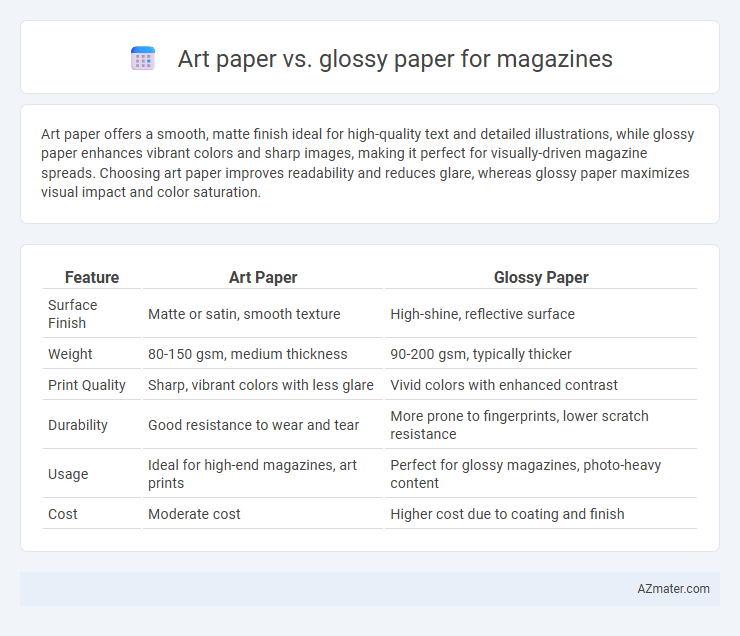Art paper offers a smooth, matte finish ideal for high-quality text and detailed illustrations, while glossy paper enhances vibrant colors and sharp images, making it perfect for visually-driven magazine spreads. Choosing art paper improves readability and reduces glare, whereas glossy paper maximizes visual impact and color saturation.
Table of Comparison
| Feature | Art Paper | Glossy Paper |
|---|---|---|
| Surface Finish | Matte or satin, smooth texture | High-shine, reflective surface |
| Weight | 80-150 gsm, medium thickness | 90-200 gsm, typically thicker |
| Print Quality | Sharp, vibrant colors with less glare | Vivid colors with enhanced contrast |
| Durability | Good resistance to wear and tear | More prone to fingerprints, lower scratch resistance |
| Usage | Ideal for high-end magazines, art prints | Perfect for glossy magazines, photo-heavy content |
| Cost | Moderate cost | Higher cost due to coating and finish |
Introduction to Magazine Paper Types
Magazine paper types primarily include art paper and glossy paper, both offering distinct visual effects and tactile experiences. Art paper features a smooth, matte finish that enhances readability and reduces glare, making it ideal for text-heavy content and sophisticated designs. Glossy paper provides a shiny, reflective surface that intensifies color vibrancy and sharpness, often preferred for photo-rich magazines and high-impact visuals.
What is Art Paper?
Art paper is a type of high-quality coated paper commonly used in magazine printing, known for its smooth surface and excellent ink absorption that produces sharp, vibrant images. It is available in both matte and gloss finishes, offering versatility depending on the desired aesthetic and readability. Art paper typically has a higher weight and brightness than standard paper, enhancing color contrast and durability in printed materials.
What is Glossy Paper?
Glossy paper is a high-shine, coated paper that enhances image vibrancy and color saturation, making it ideal for magazines emphasizing vivid visuals. Unlike art paper, which has a matte or semi-matte finish and is known for its smooth texture and durability, glossy paper provides a reflective surface that boosts contrast and sharpness. This feature makes glossy paper particularly suitable for photo-rich magazine content where visual impact is critical.
Print Quality: Art Paper vs Glossy Paper
Art paper offers a smooth, matte finish that enhances image sharpness and color accuracy, making it ideal for detailed illustrations and text-heavy content in magazines. Glossy paper features a shiny, reflective surface that intensifies color vibrancy and contrast, providing eye-catching visuals and crisp photographs for high-impact magazine spreads. Print quality on art paper minimizes glare and fingerprints, while glossy paper maximizes brightness and visual appeal, influencing reader engagement depending on the magazine's aesthetic goals.
Visual Appeal and Color Vibrancy
Art paper enhances magazine visual appeal through its smooth, matte finish that reduces glare and provides a sophisticated, professional look ideal for text-heavy layouts. Glossy paper boosts color vibrancy with its shiny surface, making images pop and delivering sharp contrasts that capture readers' attention effectively. Selecting between art paper and glossy paper depends on the magazine's emphasis--art paper favors readability and subtle elegance, whereas glossy paper intensifies color dynamics for photo-centric designs.
Texture and Finish Comparison
Art paper features a smooth, matte texture that enhances readability and reduces glare, making it ideal for magazines with extensive text. Glossy paper offers a shiny, reflective finish that intensifies colors and sharpens images, perfect for photo-heavy magazine layouts. The choice between art paper and glossy paper significantly influences the tactile experience and visual impact of magazine pages.
Durability and Handling
Art paper offers superior durability with its thicker, more rigid texture, making it resistant to tearing and creasing during handling and distribution. Glossy paper, while visually appealing due to its shiny finish, is more prone to fingerprints, smudges, and surface scratches, reducing its longevity. For magazines requiring frequent handling or long shelf life, art paper provides a more robust solution compared to the delicate nature of glossy paper.
Suitability for Magazine Content
Art paper offers a smooth, matte finish that enhances readability and is ideal for magazines focusing on text-heavy articles, in-depth features, and sophisticated, elegant visuals. Glossy paper provides vibrant, high-contrast images, making it suitable for magazines rich in photography, fashion spreads, and colorful advertisements that demand eye-catching appeal. Choosing between art paper and glossy paper depends on the magazine's content style, whether prioritizing crisp textual presentation or dynamic visual impact.
Cost Differences Between Art and Glossy Paper
Art paper generally costs less than glossy paper due to its uncoated, matte finish that requires less processing and fewer materials. Glossy paper involves a high-shine coating that increases production expenses, leading to higher prices in magazine printing. Budget-conscious publishers often prefer art paper to reduce overall printing costs while maintaining quality.
Choosing the Right Paper for Your Magazine
Art paper offers a smooth, matte finish that enhances readability and reduces glare, making it ideal for text-heavy magazine content, while glossy paper provides vibrant color reproduction and a shiny surface that makes images pop, perfect for photo-centric magazines. Choosing the right paper depends on the magazine's target audience and content style, balancing durability, aesthetic appeal, and printing costs. Consider the magazine's purpose: art paper supports a sophisticated, understated look, whereas glossy paper delivers eye-catching visuals that attract readers.

Infographic: Art paper vs Glossy paper for Magazine
 azmater.com
azmater.com